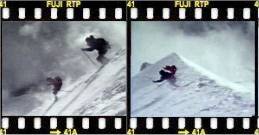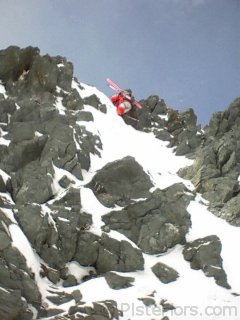That’s an adventure. I guess there’s a ski resort built somewhere around there now. ![]()

Ski Peru is the story of two skiers’ dream of descending the untamed slopes of Huascaran, although maybe “Ski Peru and die” would be a more appropriate title given the tragic climax to Peter Chrzanowski’s Peruvian odyssey. Filmed long before today’s adrenalin charged ski videos on heavy 16mm movie cameras there is no heavy rock soundtrack, no helicopters, no roboskiers mainlining powder at Mach 5.0. It is a slow moving film that explores man’s relationship with the mountain and what it is to ski into the unknown.

The plan was to descend the un-skied slopes of the Huascaran South (6750m) by the south-west face. Little did Peter and his team know that in the dying embers of the 1970s Huascaran was at the epicentre of an international competition to ski from the summit. Along with the “Gringos” two other teams were racing to be first. Pioneer of extreme Patrick Vallençant and Dominique André were pitted against the young Turks of Jean-Marc Boivin and Clusaz guide Michel Poëncet.
After nearly getting lost in freezing temperatures Chrzanowski’s team were faltering at the foot of the monster. Patrick Vallençant picks up the story.
I though that Jean-Marc was ahead, it was 11am, I gave the mule a prod and upped the pace. The road which seemed so long to us three weeks previously now seemed short, in the early afternoon we reached base camp at 4800 meters. From our tent we observed a group of three climbers walking down the moraine. They looked done in. They had been trying to climb Huascaran for the last five days. We were surprised; the group were part of a team including two Canadian skiers, which confirmed the rumours of the Indians.
We asked them if their friends had already skied the summit. They gulped down the tea we offered them. They had come to Peru to study the geology. They made marks and measurements and filmed everything. The two Canadians had piggy-backed onto the trip to make a ski film. The geologists were obviously not happy to accept the suffering that altitude brings and preferred to leave the skiers and their porters at the foot of the mountain.
The game wasn’t up for us yet. We could maybe reach them in a day of hard climbing and who knows? Do the summit together? I spotted another face at the camp, Frédéric Labaye. What a coincidence, he told us “they area a bit overwhelmed by the task, if you try you can catch them, they are carrying a huge amount of gear.”
The next day, at 10am, we crossed one of the Canadians, he had given up and was skiing down. He didn’t seem to welcome our presence or maybe he was just tired? He skied extremely well. Our prey could not be far, at 2pm we caught up with Peter Chrzanowski. He was suffering. His porters were loaded down with gear. We suggested resting the night where we were and continuing together the next day.
We had to take a look at Peter’s gear. He had a diver’s knife that weighed over a kilo, it said everything about his lack of experience. He was also carrying two cameras. One he could attach to his helmet, the other, incredulously, had a mount for ski shoes. We understood why we had caught him so quickly. On the plus side, an amazing amount of high altitude food and an isolated tent. In exchange for food and lodging we agreed to carry a camera to the summit and to help Peter on the climb.
We had just finished supper when a couple of silhouettes appeared. Was it Peter’s friend? Impossible. We then noticed they had skis fixed to their sacks. Peter pulled a whistle from his pocket and began to blow furiously. Nothing he could do would surprise us now.
“You are a real bastard” was how Jean-Marc Boivin greeted me. “What me a bastard? I thought you were in front so I had no reason to wait for you”. It was Michel, normally taciturn, who calmed things down “We are not going to fight with our ice-axes, you two make up and we’ll go to the summit together”. The absurdity of the situation struck me. Here we were, on a summit that had never been skied and on the the same day everyone was chasing after each other. Peter wanted to be first. We thought we were chasing our friends who were in fact chasing us. It should have been on television.

Michel Poëncet ski touring at les Arcs, 2001
We ate a chilling breakfast. Dawn arrived quickly. A few clouds floated in the sky, they would grow thicker during the day. Crevasses, which hadn’t caused us many problems were now open. From the go Peter had trouble following us. We had to be at the summit today and there was no question of slowing down. The ice ridge would decide it. We were already 50 meters higher up when the Canadian reached the obstacle. Dominique was very worried to see him tackle the ridge akimbo using his knees and not his crampons. I felt a bit responsible for him and because we were not really savages, I climbed down to help with my rope. Michel and Jean-Marc continued climbing. I grumbled a bit, the snow was hard. Then, close to Peter I offered my hand, the gesture was superb; it merited a photo in Paris-Match. I then had to convince him to descend.
“You won’t make it, it’s okay. I will film our descent and give you the images”. I was also worried about the pair climbing on and catching up and wanted Peter to make a quick decision. The promise to film clinched it. So, without Peter I took the rope and caught up with my “friends”. They were not too far ahead and in 30 minutes I was on their tail. First of all I recovered and stayed behind. Then feeling better I caught up with Michel. He was an incredible climber.
We were at 6400 meters. We had already climbed 500 and there were 400 left to do. Everything had gone well. The steep slope, the breakable snow, forbade any competitiveness. Now Michel and I were in front, Jean-Marc was losing ground, Dominique stayed in contention. We didn’t utter a word. Three hundred meters more, clouds covered the summit. The wind grew violent, the snow harder. With tiredness thoughts turned to immediate preoccupations. Plant one foot once, chest forward, relax the shoulders. I counted my steps.
A race started with Michel. We took turns ahead. In these conditions it was difficult to pull ahead but the snow grew harder needing less effort. Michel began to fall back. He stopped, head forward, hand on one knee. The shallower slope to the summit was just ahead. It was time to put on the pressure.
One, two… fifteen paces. Michel had caught me. I had to keep it together, taking short, fast breaths. I threw a glance at my rival, he stopped. I let my heart recover. Two hundred meters to the top. Now I could break away. Dominique and Michel vanished into the cloud. I didn’t stop to the summit obscured by intermittent clouds.
At the summit I was dead beat with my effort. I could only sit down. The wind chased the clouds and transported hard particles of snow. I was sitting and it seemed to be the most fantastic thing in the world. I gobbled my last food. In these moments of extreme tiredness the summit was a world of immediate needs. Eat, recover, breath, drink.
It was already 3pm, I began to grow cold. Two shadows emerged. Michel then Dominique dropped their sacks. We waited a long time then, chilled to the bone and the hour advancing we climbed down to help Jean-Marc still 50 meters lower down. Opinionated, he didn’t want to know and continued on to the top.
We didn’t want to ski the normal route. Too easy and there was no question of tackling the west triangle that was so completely covered in ice. That left the south-west face. That vast steep slope which we had observed while climbing ended in an important crevasse zone which we hoped to ski around.
Jean-Marc had joined us and we plunged onto the face inclined at 45 degrees. We were directly above the Huaraz valley the sensation of altitude was just one of the pleasures. It was already 5pm. As I had promised to film our descent I took some shots. They would be nice as large columns of clouds rose and reddened in the setting sun. The task ruined a good part of my descent; to gain time I kept the camera in my hand which stopped me from planting my poles; in the icy snow it was very unpleasant. We rapidly lost height and were once again struck by what had taken so long to climb took so little time to descend.
At the bottom of the big face I put the camera away to focus on skiing. The wind blown snow formed corrugations that were nasty. They controlled our turns. Our legs were tired. We were keen to reach the bottom.
At the crevasse zone we split up to find the best route until we came to a dead end in a maze. Michel took a small valley and broke through a snow bridge. He only just had time to throw himself to the side. We climbed, descended and climbed. We started to grow worried. We found ourselves blocked by a huge crevasse. There was a snow bridge but it looked dodgy. If we couldn’t cross we were not sure that we had the energy to climb. A bivouac was the only choice. Despite the hunger, thirst we were pleased to rest our bodies. Skis served to insulate us from the snow. The sky was clear, it would be a long, cold night. We missed our sleeping bags back at camp. I couldn’t sleep and spent time massaging my feet to avoid frost bite.
In the morning we had to get going. Without food, without water, running on empty we wouldn’t last a second bivouac. Finally Jean-Marc found a way through. We climbed a ridge. Michel fell into a crevasse that was blocked with snow and following the bottom we emerged by an ice fall at the edge of the gentle glacier slopes we had followed two days previously. There was no question of perfect skiing. We only thought of getting down, eating and changing our shoes.
“I definitely left my boots here, have you found yours?” I realised that an Indian was probably walking around in my boots, he would be comfortable, I take a size 46! I would have to walk barefoot to Mouchoc. Stones, cactus spikes, nothing missed my feet.
23 June 1979. Face South-West of Huascaran South (6750 meters).
Ski Peru by Peter Chrzanowski can be ordered internationally on DVD from Explorex. A rare document of a first descent by some of the piononeers of extreme skiing.
Ski Extreme. Patrick Vallencant. Flammarion. 197 (out of print).
That’s an adventure. I guess there’s a ski resort built somewhere around there now. ![]()